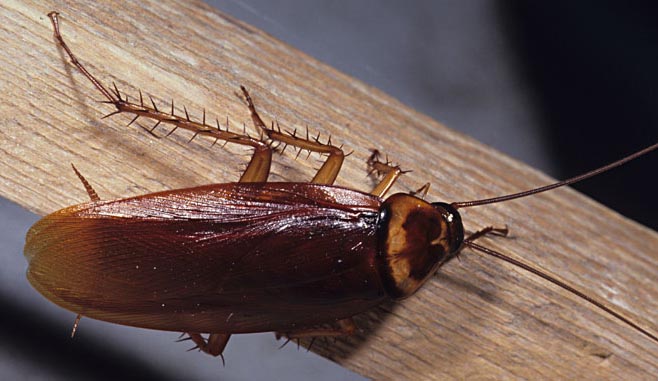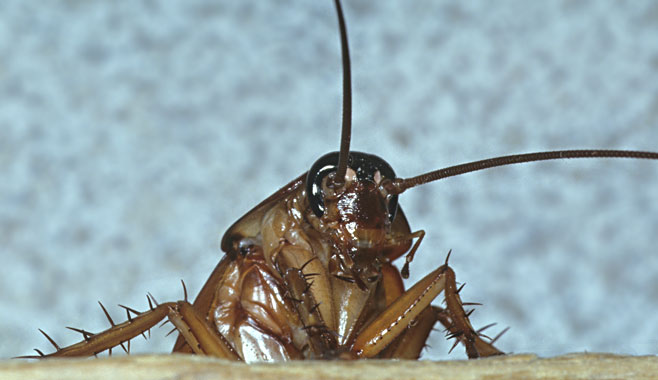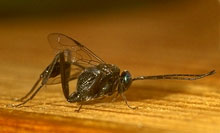|
Periplaneta americana (American cockroach)
Life
> Eukaryotes >
Opisthokonta >
Metazoa (animals) > Bilateria > Ecdysozoa
> Panarthropoda > Tritocerebra > Phylum:
Arthopoda > Mandibulata >
Atelocerata > Panhexapoda >
Hexapoda
> Insecta (insects) > Dicondyla > Pterygota >
Metapterygota > Neoptera > Polyneoptera >
Dictyoptera (cockroaches, mantises and termites) > Family: Blattidae
 |
 |
|
Periplaneta americana (American cockroach), in Cape Town home. [photos
H.G. Robertson, Iziko ©] |
Distribution and habitat
Despite its name, the American cockroach is not native to
America but rather West Africa. It has been introduced to just about all parts
of the world, thriving in moist, warm places, usually in association with human
habitation.
It is the most common of the cockroaches found in
people's homes in coastal areas of southern Africa (e.g. in Cape Town) and is
also found in most other urban areas in the region. It likes
warm, moist cavities such as those found behind paneling beneath the kitchen
sink. It is also found in large numbers in sewers and some homes are
particularly vulnerable to repeated infestation by cockroaches from nearby
sewerage systems (particularly old ones that have moist spaces where they can
live).
Life cycle
- Like almost all cockroaches, eggs are laid in an egg case called an
ootheca. Each egg case contains about 14 eggs. The egg case is usually
hidden in a crevice and egg development lasts 1-2 months. A single female
can produce about 12-24 egg cases over the warm summer months.
- The nymphs that hatch from the eggs undergo 13 moults over a period of 6-12 months before they
reach maturity.
- Adults are about 30 mm long and often live more than a
year, so with the younger life stages included, the life span can total
nearly two years.
Natural enemies
 |
|
|
Evania appendigaster. [photo S. van Noort ©] |
|
The
wasp
Evania appendigaster parasitises the
egg cases of the American cockroach. In cockroach prone areas, this wasp can
often be seen flying and strutting around on the window sill. It is black with a
funny, small triangular abdomen. It does not sting, it is not dangerous, and you
should regard it as friend, not foe.
Importance
-
As you can imagine, having a cockroach
wandering out of a sewer into your kitchen and on to food, can't be good for
hygiene. Thus these cockroaches can contaminate exposed food with bacteria.
-
American cockroaches have a very strong,
distinctive smell and can cause allergic reactions.
-
Some people get quite freaked out
by these insects as they are large, fast, spikey, smelly and a
health hazard.
Control
-
Sanitation. These
cockroaches feed mainly at night. If there are food remains, dirty
plates, crumbs on the floor or scraps left exposed in your kitchen
overnight you are basically providing them with an ongoing food
supply that is going to swell their numbers. Clean your kitchen each
evening before going to bed. It's an idea to put the plug in the
sink overnight as this will stop them entering the kitchen through
the drain.
-
Design of your home.
American cockroaches can be difficult to control adequately if they are
living in cavities that cannot be removed. For instance, kitchen
cupboards are often constructed with a back panel so that there is a
cavity between the panel and the wall. If such a cavity is not sealed,
cockroaches are likely to find it and breed in it, particularly if the
wall is damp or the panel is beneath a sink or basin.
Cockroaches like hiding under fridges and stoves or in horizontal or
vertical cavities at ground level.
-
Insecticides. Spraying a surface
spray type of insecticide in cavities where cockroaches reside and along
skirtings on the floor can be effective in killing some.
-
Cockroach traps. These consist of a
sticky surface on which the cockroaches get stuck. Put them out in places where
you see a lot of cockroaches.
Links
References
Text by Hamish G. Robertson
|
